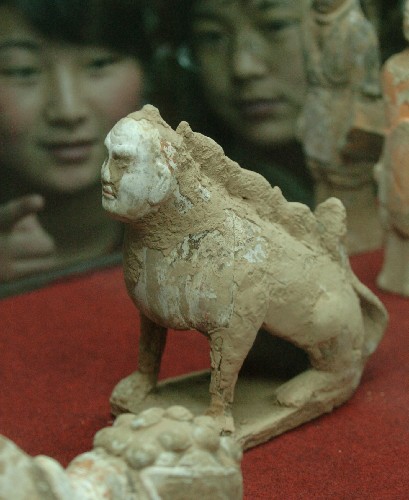Tomb Figurines, Buried Mystery
Updated: 2007-07-16 08:41
Sagas of Han Burial Figurines

Dancers and acrobats
Years of war followed after the collapse of the Qin Dynasty, leading to a weak economy in the following Han Dynasty (206 B.C.-220 A.D.). Even the emperor couldn't find four horses of the same color for his cart. The officers could only take rather slow oxcarts.
Hence, the burial objects of the Han Dynasty couldn't hold a candle to Qin's grandeur. Though the figurines didn't shrink in number, they were much smaller-- 50-60 centimeters on average, about one-third of the average height of Qin terracotta. Life-sized figurines like Qin terracotta warriors were no longer made.
Small as they are, the Han figurines were superior in sculptural art. The facial features were delicate and true to life. Individual facial expressions were presented with accuracy. The body figures were well-proportioned and elegant. Even the weapons and daily utensils in their hands were made of iron or bronze and were proportional to the height of the figurines. In the hand of a pottery figurine is a circular copper coin whose diameter is less than 1 centimeter. But on its face, two inscribed words indicating its face value, "°λΑ½," were clearly visible.
Tomb Figurines of the Warring Time

Beast Figurine with man's head; Northern Qi(550-577AD)
After the Han Dynasty, the country was once again in combat with warlords. People struggled to live and could no longer pay so much attention to their afterlives. The burial customs became simpler and less extravagant.
Though tomb figurine making declined for some 300 years, there were still some artworks worthy of attention. In the tombs of the Eastern Jin and Southern Dynasties (317-589 A.D.), pottery oxcarts can always be found near the human figurines. Why did the aristocrats prefer oxcarts to carriages? The reason was that the upper class, dominated by scholarly officials, was pursuing a living style aloof from the worldly tastes, and slow oxcarts were their favorite means of transportation.
In Northern China where 16 regimes were successively established by nomads,
the tomb figurines were masculine. In addition, the appearance of camel
figurines shows that the nomads began migrating on a large scale to central
China, paving the way for another unification of China.
 | 1 | 2 | 3 |  |

